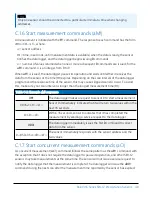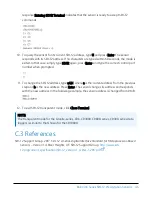
To use this command, the scan interval should be 10 seconds or less. The response to each
command has the form
atttn<CR><LF>
, where
a
= sensor address
ttt
= time, in seconds, until measurement data is available
nn
= number of values to be returned when one or more subsequent
D
commands are issued
See the example in
(p. 41). A data logger has three sensors wired into terminal C1. The
sensors are addresses X, Y, and Z. The data logger will issue the following commands and receive
the following responses:
Table C-3: Example aC! sequence
XC!
The data logger makes a request to sensor X to start
a concurrent measurement.
X03005<CR><LF>
Sensor X immediately indicates that it will have five
(05) values ready for collection within the next 30
(030) seconds.
YC!
The data logger makes a request to sensor Y to start
a concurrent measurement.
Y04006<CR><LF>
Sensor Y immediately indicates that it will have six
(06) values ready for collection within the next 40
(040) seconds.
ZC!
The data logger makes a request to sensor Z to start
a concurrent measurement.
Z02010<CR><LF>
Sensor Z immediately indicates that it will have ten
(10) values ready for collection within the next 20
(020) seconds.
ZD0!
After 20 seconds have passed, the data logger starts
the process of collecting the data by issuing the first
D
command to sensor Z.
Z+1+2+3+4+5+6+7+8+9+10<CR><LF>
Sensor Z immediately responds with the sensor
address and the ten values.
XD0!
10 seconds later, after a total of 30 seconds has
passed, the data logger starts the process of
collecting data from sensor X by issuing the first
D
command.
RainVUE-Series SDI-12 Precipitation Sensors
41
























